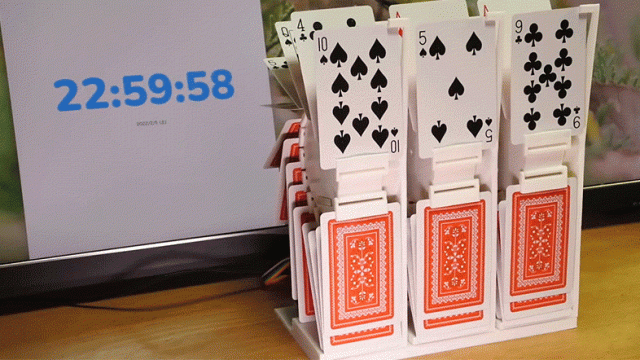Before LCDs and LEDs became cheap enough to add to nearly any device, mechanical flap displays were used in large-scale signage and bedside alarm clocks for improved legibility. Shinsaku Hiura has recreated one from scratch with a fun twist: they’ve replaced the numbered flaps with playing cards, a design that will appeal to anyone who knows you never count your money when you’re sittin’ at the table.
Take a moment to browse Hirua’s YouTube channel and you’ll find a hardware hacker who seemingly has an obsession with reinventing the clock, with unique and novel designs that focus on mechanical functionality. Flip clocks are probably most commonly associated with the giant displays that train stations and airports used to rely on to provide arrival and departure times for passengers, but before glowing red LEDs became popular, they were also used in alarm clocks as a way to display the time that was easy to read, even to someone who was half asleep.
They worked by spinning a wheel which had a series of flaps attached to it with numbers printed on them (half a number on one flap, and the other half on the flap right next to it) until the current time was displayed. They weren’t silent, but the sound of the spinning flaps still has a certain old school appeal to it, and we’ve seen other hardware hackers use the displays for fun projects: like a split-flap display that can be used to play Tetris.
Hiura’s Casino Clock was more or less built from scratch using custom 3D-printed components including spinning wheels with hinged holders to which standard playing cards are attached. Inside each of the three wheels is a stepper motor which rotates it until the playing card representing the current time — synced over wifi — is displayed. The Ace is low, representing 1, Jacks are 11, Queens are 12, and the Joker cards stand in for zero.
The most enjoyable part of a flip clock is the sound of the flaps falling as the wheels spin, so to maximise that experience, Hiura randomly arranged the playing cards on each wheel (with the order of the cards specified in the source code) so that extra spinning is required every time a minute ticks by. It makes for a fun desk distraction, but it’s hard to imagine anyone wanting this thing on their bedside table all night long.
